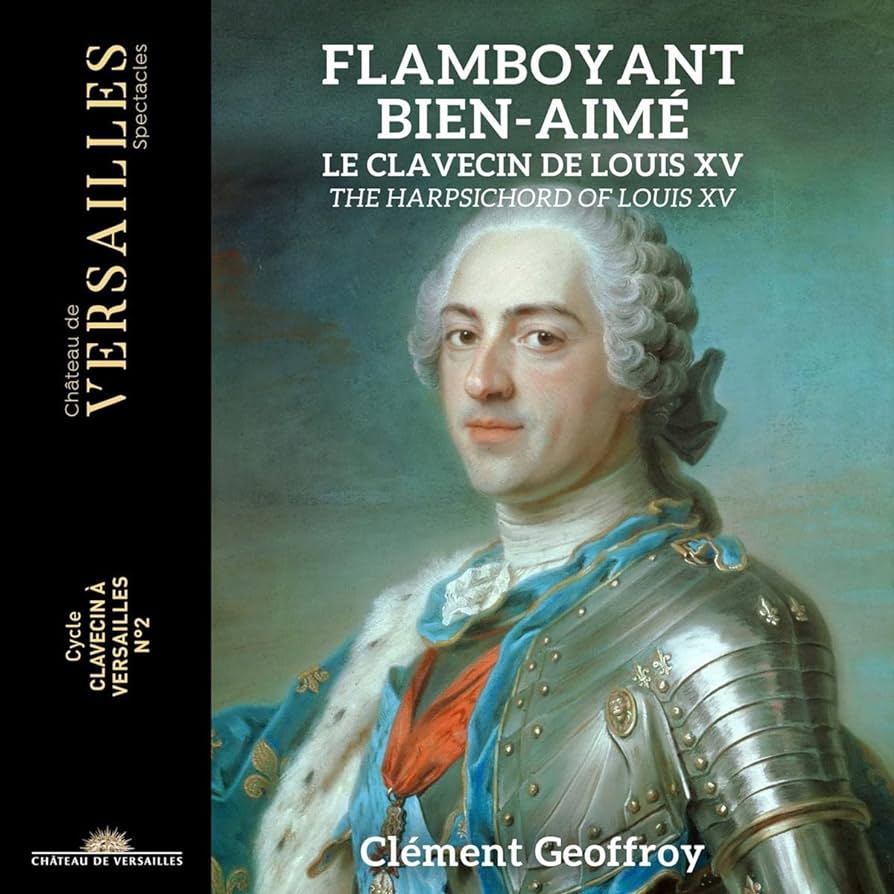“Flamboyant bien-aimé”: The Harpsichord of Louis XV
A great disc. Clément Geoffroy is a superb harpsichordist; and the repertoire is perfectly chosen

I do sympathise with harpsichordist Clément Geoffrey hone he decribes the trials and tribulations of reducing the vast amount of harpsichord music from the time of Louis XV into a programme lasting 77 minutes. He opted to swerve François Couperin and his musical portraits for Rameau and the so-called “Ramists”
The harpsichord is a tricky instrument to record. The venue here was the chapel of the “Petit Trianon,” located within the vast gardens of the Château, and the instrument was tuned to temperament after Michel Corbette (1753).
Certainly, we know Rameau: his La Dauphine heard here, offers a perfect example of notated improvisation; the title refers to Marie-Josèphe de Sade, mother of Louis XVI. Here is Geoffrey in La Dauphine, and also playing a piece heard later in the programme, the delightful Les Étoiles by Corrette:
Geoffrey plays Rameau and Corrette
The French penchant for character pieces for harpsichord is fascinating. Le Pothouin by Jacques Duphly (1715-1789) is remarkable, really quite dark (and, in the programming order, the perfect contrast to a piece by Charles Noblet - see below), while Duphly's La De Vaucanson is virtuoso, and yet still somewhat occluded (in registral terms). Both of those are from the Quatrième livre de pièces de clavecin, 1768; the final Duphly piece is from the 1744 Premiere livre de pièces de clavecin, a “Rondeau” of the utmost gentilité. Geoffroy describes the inclusion of music by Duphly as he “wanted to play all four of his collections, so beautiful are they,” the product of a composer whose entire output is for the harpsichord.
The Château de Versailles Spéctacles series has gifted me so many discoveries over the years. The one from this disc, for me, is Charles Noblet (1715-1769), heard here via an Allemande from his Premier live de pièces de clavecin of 1756, although a piece by Rameau I was previously unaware of, Les Tendres Plaintes, is itself a miniature miracle of expression, and Geoffroy is a superb interpreter. He never lets rubato interrupt the baseline pulse, and the music grow immeasurably for it. Its companion piece in the running order, Les Cyclopes, is certainly more famous, a toccata.
We met Bertrand de Bury (1720-1785) in our post on another Château de Versailles Spectacles disc, Festin Royal du Marriage du Comte d'Artois, 1773; at the time, I said of the two pieces by Bertrand de Bury - an ‘Air lent’ (brave horn players here) and a ‘Rondeau lèger,’ both from Hylas et Zélis (1762) - that both pieces make me want to know a lot more about this composer. So here we have two pieces: a Menuet that belies its title (Menuet I: Zéphir & Menuet II: Flore).
Antoine Forqueray (1699-1782) was one of the two most famed viol composers of his generation (the other was Marin Marias: see this post). Anyone who thinks French Baroque harpsichord music can't be dramatic needs to hear La Angrave ...
We previously covered a whole disc of music by Pancrace Royer (1703-1755) courtesy fo Christophe Rousset and Les Talens Lyriques: Surprising Royer was the title of that disc (link to post). Royer”s L'Aimable is the perfect opportunity to show off the sweetness of the harpsichord used by Geoffrey: a Jean-François Chaudeurge after Jean-Claude Goujon's instrument dated as before 1749. Royer's richly textures (which comes across as almost luxuriant on this disc) La Marche des Scythes is a masterpiece and a miracle of virtuosity: when the music begins to swirl via roulades of arpeggiation, the effect is truly discombobulatory, bu is only a hint of the heights of virtuosity this piece achieves in its later stages. A truly magnificent piece in a truly magnificent performance.
Geoffrey's performance of Jacques Duply's La Du But makes me wish we had more music by this composer: only four books of harpsichord music are extant: we have only four books of harpsichord pieces (a total of 52 works). This one comes from the fourth book, of 1768. Geoffrey's superbly even trills are an absolute joy here.
As the disc moves to its conclusion, it is Rameau who comes to the forefront, The grandeur of his Musette en rondeau contrasts with the famous Tambourin (both from Pièces de clavecin aves un méthode pour la mécanique des doigts, 1724). I do profess a preference for the young Christophe Rousset on L'Oiseau Lyre in Tambourin, though: Rousset has that bit more life about his performance:
One of the great discoveries here is another piece by Bernard De Bury: his Chaconne from the Premier live de pièces de clavecin, 1737, eight minutes of genius. And what a way to finish, with Claude Balbastre's gloriously celebrational Contrdanse de Pygmalion (Rameau) from his Réceuil d'airs hoists de pleusieurs opéras, accomodés pour le clavecin.
The whole programme is fascinating. It opens, in fact, with a recent discovery: a piece, simply called “Prélude,” by “Dubuisson”. His books of pieces was published around 1733, ad we know next to nothing about him. But one thing is for sure:this short Prélude is lovely, highly ornamented, dignified, and noble.
A great disc. Clément Geoffroy is a superb harpsichordist; and the repertoire is perfectly chosen.
To close, a composer who really needs more exposure: Scarlattti père (Alessandro Scarlatti). Here is Geoffrey as harpsichordist on a 1748 Colesse, restored by Laurent Soumagnac in Alessandro’s magnificent cantata Lucretia Romana, joined by soprano Eugénie Lefèbvre and viola da gambist Julie Dessaint:
One can purchase this Château de Versailles Spectacles disc, Flamboyant Bien-Aimé, from Amazon at this link. In the absence of a Spotify for this disc, I append one disc of Toccatas, Partitas & Suites by Johann Adam Reincken, and one disc with Gwenaëlle Alibert of Vivaldi Concertos arranged for two harpsichords, both featuring Clément Geoffroy:
